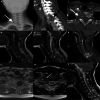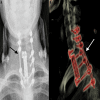Anteroposterior Combined Surgery of a Rare Massive Epithelioid Hemangioendothelioma at the Cervicothoracic Junction
- PMID: 37551289
- PMCID: PMC10404447
- DOI: 10.7759/cureus.43032
Anteroposterior Combined Surgery of a Rare Massive Epithelioid Hemangioendothelioma at the Cervicothoracic Junction
Abstract
Epithelioid hemangioendothelioma is a rare mesenchymal tumor of vascular endothelial origin. Non-soft tissue epithelioid hemangioendothelioma can also be seen in different organs. Although chemotherapy has been used in some patients, complete surgical removal of the tumor tissue has proven to be the most durable solution. A 15-year-old female patient was admitted to our institution with right arm and neck pain. The patient complained of numbness and weakness in the right hand. Computerized tomography indicated an expansile lesion exhibiting osteolytic features located predominantly on the right side of the corpus, pedicle, lamina, and lateral processes of the C7-T1 vertebra. The patient underwent a surgical procedure involving the application of a bilateral C4-5-6 lateral mass screw, left C7-T1 pedicle screw, and bilateral T2-3 pedicle screw and fusion. The complete residual neoplasm was surgically removed during the procedure. Due to the rarity of epithelioid hemangioendothelioma, the existing literature on this topic is confined to case reports, supplemented by a small number of retrospective descriptive case series that aimed to improve our understanding of the clinical, pathological, and molecular features of the condition, as well as to guide potential treatment strategies.
Keywords: combined surgery; craniocervical junction; epitheloid hemangioendothelioma; pediatric neurosurgery; spinal tumor.
Copyright © 2023, Cine et al.
Conflict of interest statement
The authors have declared that no competing interests exist.
Figures





Similar articles
-
Pediatric cervical kyphosis in the MRI era (1984-2008) with long-term follow up: literature review.Childs Nerv Syst. 2022 Feb;38(2):361-377. doi: 10.1007/s00381-021-05409-z. Epub 2021 Nov 22. Childs Nerv Syst. 2022. PMID: 34806157 Review.
-
Case report: Surgical treatment of a primary giant epithelioid hemangioendothelioma of the spine with total en-bloc spondylectomy.Front Oncol. 2023 Mar 28;13:1109643. doi: 10.3389/fonc.2023.1109643. eCollection 2023. Front Oncol. 2023. PMID: 37056332 Free PMC article.
-
Pulmonary epithelioid hemangioendothelioma presenting with vertebral metastases: a case report.J Med Case Rep. 2014 Jun 18;8:201. doi: 10.1186/1752-1947-8-201. J Med Case Rep. 2014. PMID: 24942542 Free PMC article.
-
A case report of parotid gland epithelioid hemangioendothelioma.Front Surg. 2024 Apr 22;11:1367059. doi: 10.3389/fsurg.2024.1367059. eCollection 2024. Front Surg. 2024. PMID: 38712336 Free PMC article.
-
Primary intracranial epithelioid hemangioendothelioma: a low-proliferation tumor exhibiting clinically malignant behavior.J Neurooncol. 2012 Oct;110(1):119-27. doi: 10.1007/s11060-012-0945-x. Epub 2012 Aug 11. J Neurooncol. 2012. PMID: 22886511 Review.
Cited by
-
The Necessity of Extensive Decompression for Spinal Epidural Hematoma: A Case Report and Literature Review.Cureus. 2023 Aug 27;15(8):e44192. doi: 10.7759/cureus.44192. eCollection 2023 Aug. Cureus. 2023. PMID: 37641725 Free PMC article.
-
Primary Epithelioid Hemangioendothelioma of the Spine: A First in Africa. A Case Report and Literature Review.Clin Case Rep. 2025 Jan 31;13(2):e70165. doi: 10.1002/ccr3.70165. eCollection 2025 Feb. Clin Case Rep. 2025. PMID: 39895842 Free PMC article.
-
High-Frequency Bipolar Coagulation Limits Epidural Fibrosis in Lumbar Microdiscectomy.Cureus. 2023 Sep 12;15(9):e45077. doi: 10.7759/cureus.45077. eCollection 2023 Sep. Cureus. 2023. PMID: 37705564 Free PMC article.
-
Giant Ependymoma Removal via a Skipped Myelotomy Technique.Cureus. 2023 Sep 1;15(9):e44511. doi: 10.7759/cureus.44511. eCollection 2023 Sep. Cureus. 2023. PMID: 37790047 Free PMC article.
References
-
- Thoracic epithelioid hemangioendothelioma: clinical demonstration and therapeutic procedures. Graça LL, Almeida Cunha S, Lopes RS, Carvalho L, Prieto D. Port J Card Thorac Vasc Surg. 2022;29:39–44. - PubMed
-
- Epithelioid hemangioendothelioma in children: the European Pediatric Soft Tissue Sarcoma Study Group experience. Orbach D, Van Noesel MM, Brennan B, et al. Pediatr Blood Cancer. 2022;69:0. - PubMed
-
- New molecular insights, and the role of systemic therapies and collaboration for treatment of epithelioid hemangioendothelioma (EHE) Stacchiotti S, Tap W, Leonard H, Zaffaroni N, Baldi GG. Curr Treat Options Oncol. 2023;24:667–679. - PubMed
Publication types
LinkOut - more resources
Full Text Sources
Miscellaneous
